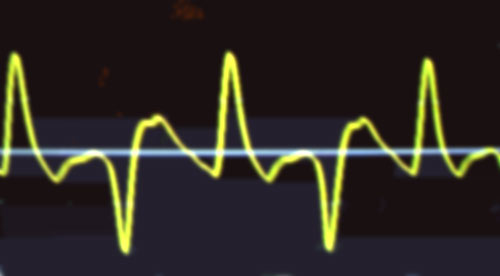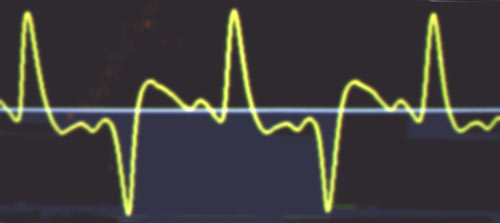Wurlitzer 4600 series
North Suburban Hammond Organ Service
The reason for connecting the load resistor to the shallot of the reed instead of to the pickup is as follows. Have you ever noticed how in your home stereo system, for example, you have just two wires going to either speaker? And yet, in spite of that, all of the extremely complex audio information of, for instance, an entire symphony orchestra is all represented by a single AC audio waveform that requires only two wires. Along the same principle, Wurlitzer found that they could "common" or tie together, all of the reed shallots and then just have one common load resistor and one blocking capacitor, and no matter how many notes the musician might use at any instance, and no matter whether he's using one, two, or all three pickups, the resulting multitude of individual notes and tones can all be combined into one single AC audio waveform that represents all of them. This of course makes the circuitry much simpler than if they had to use individual load resistors and blocking capacitors for every single pickup on each reed individually.
In actuality, Wurlitzer divided the group of 85 reeds into two subgroups, called appropriately bass and treble. Reeds one through twenty-four, representing the first two lowest octaves is considered the bass group, and the remaining sixty-one reeds comprise the other or treble group. Although these Wurlitzer electrostatic organs are considered single channel or mono instruments, initially in the amplifier, the signals from the bass and treble reed groups are processed differently in separate channels.
Bass is accentuated on the lower frequency tones, and for the remainder, there is some emphasis on higher frequencies. Unlike the Hammond with its upper limit of 6 kHz and the need to suppress its key clicks, the Wurlitzer electrostatic organ produces lots of high harmonics on the tones that originate from the front edge pickups. Also, there are no key clicks in its keying system. Therefore there is no need to limit high frequencies where they can be useful, thus the treble emphasis for signals coming from reeds 25 through 85.
There is also the consideration of vibrato. This periodic and regular wavering effect which adds so much to vocal music and much popular instrumental music as well does not sound good on very low bass tones. Why this is so, I don't know, but I would guess that it is because on very low pitches, the frequency of the tones is not too much higher than the vibrato frequency itself. In all better-designed pipe organs, for example, the vibrato/tremolo effect is kept away from just about all pipes with fundamental pitches below Tenor C. In keeping with this tradition, the vibrato effect in the Wurlitzer electrostatic organs likewise effects only Tenor C and tones that are above it.
In spite of their delicateness, these free reeds are extremely pitch stable. The few remaining electrostatic Wurlitzers in existence today are at least fifty years old. I have seen as of now five of them, and all remain in excellent tune. Free reeds, once manufactured and correctly tuned will stay in tune indefinitely, especially if they are kept clean, which is one of the features of the electrostatic Wurlitzer. Because the reeds are not used for acoustic sound production, they can remain in a hermetically sealed environment where they are kept free of dust and dirt.
 Waveform of pickup over the free end of the
reed.
Waveform of pickup over the free end of the
reed. Waveform of pickup over the center of a reed.
Waveform of pickup over the center of a reed. Waveform of one front edge pickup.
Waveform of one front edge pickup. Waveform of an adjacent front edge pickup.
Waveform of an adjacent front edge pickup.
Free reeds are sensitive to temperature changes, surprisingly going slightly flat as temperature increases. However, the pitch change resulting from normal temperature fluctuations is so small that it can only be measured by sensitive electronic equipment. After the instrument has been running for a while, the air temperature in the reed unit will rise about five degrees C above ambient. This temperature rise is most likely caused by the centrifugal compressor. The effect, however, on the pitch of the reeds is a lot less than even one cent which is 0.01 semitone. The normal tuning tolerance for musical instruments is greater than that so we may therefore consider that a Wurlitzer ES instrument has essentially permanent and constant tuning.
Metal fatigue of free reeds may occasionally cause a noticeable detuning, however in these instruments, the amplitude of reed vibration is fairly small, much less than what you would find in an accordion, because it's not necessary for these reeds to make loud noise as the reeds in an accordion have to do. This low amplitude mechanical vibration therefore is not conducive to creating metal fatigue, and the reeds' maximum vibration is much less than that required to approach their elastic limit. On the next page we'll look at the interior of a 4600 series instrument and see how all of this stuff is arranged. Above we have examples of the waveforms that result from the three pickups of a typical reed in this instrument.
Notice that I have here pictures of the waveforms from the front edge pickups of two adjacent notes or pitches, and notice that while they are similar, they are at least slightly different. The reason for this is simply due to the extremely tight tolerances that pertain to this type of a tone generating system. The distance between the tip of the reed and the position of the front edge pickup is very critical, and even a change that is less than we can see if we play around with this adjustment will make a noticeable difference in the harmonic content of the resulting generated tone. A second, and even more important criterion is where the pickup is in relation to the reed tip's arc of vibration which then changes the relative timing between the two generated spikes. The result of this unique characteristic is that while being essentially similar, and likewise sounding essentially the same, there are minute differences between the tones from one note to the next. In normal listening and playing, you do not really notice them, but if you listen individually, very carefully, and play successive tones on this instrument and have it registered so that you are listening exclusively to the tone that is resulting from the use of front edge pickups, you can actually hear these slight differences. Perhaps one tone will sound a little more "clarinetty" than the next tone, which might slightly suggest a violinlike tone. Essentially they will sound alike. Individually they will have subtle differences, and as an oscilloscope look shows in these pictures, the waveform will display easily seen visible differences.
This above fact makes each such instrument have a unique tonal "fingerprint" for lack of a better term. Through really careful listening to some of Ken Griffin's recordings where he used such an instrument, we can actually tell that not all of these recordings were made from the same instrument. However, it's significant to realize that essentially, this is sort of splitting hairs, as it were. If you happen to have a recording of an electrostatic Wurlitzer of this type, unless the organ is registered a certain way and unless you really listen super critically, you will not be aware that this is happening. If you have access to such an instrument so that you can carefully play and listen to successive keys individually, then it is possible that you will notice very slight differences. But then too, if you listen to the effect of a typical Leslie speaker really carefully, you will find that as you change your location relative to the Leslie, even moving just a few inches in the room where the Leslie is, you will notice subtle differences in the unique Leslie tremolo sound of individual organ notes which are due not to the instrument, but to the way each different pitch's sound wave behaves in the room where the Leslie is located and how the room affects the waveforms of the sounds as they emerge from the rotating elements in a speaker. Likewise, with a Hammond organ, where the extremely good Hammond vibrato is produced electrically in the instrument and you hear the vibrato in tones coming from stationary speakers, you can still notice subtle differences in the vibrato as you move around in the room relative to the Hammond tone cabinet.
People's hearing and their perception of sounds are very well developed, and the human brain in processing sound performs very complex analyses continuously. However, most people are not aware that they are doing this. Just the fact that you can recognize the voices of individual people, when all people produce voice the same way, involves a lot of "processing power" to use a computer term, but we do this without any conscious knowledge about how this works, or that we are even doing a number of complex actions simultaneously. But I think it is fair to say that practically anything that makes any kind of sound or noise, even if it is only one of a million or more similar things, will introduce lots of subtle differences. And in order to understand the speech of other people, we do thousands and thousands of individual analytical processes continuously and never pay even the slightest bit of conscious thought to what we are doing as we listen to somebody talking and then respond. So it should be no surprise at all that a musical instrument will introduce its own unique sonic fingerprint on what it does when we play it.